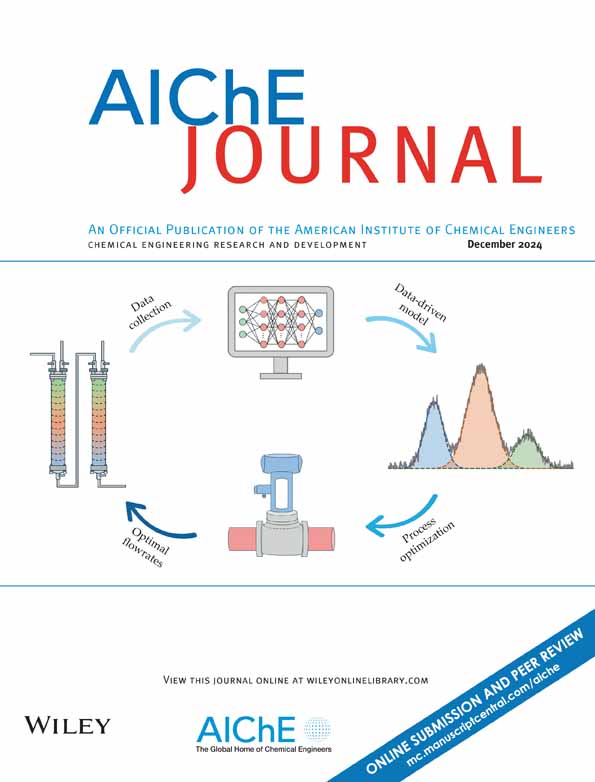Mechanism unraveling for efficient hydrodeoxygenation of fatty acids/esters over highly stable Ni/Nb2O5-SiO2 catalyst
IF 3.5
3区 工程技术
Q2 ENGINEERING, CHEMICAL
引用次数: 0
Abstract
The conventional hydrodeoxygenation process for sustainable aviation fuel production using Al2O3-supported Ni-Mo sulfide catalyst faces dual challenges: sulfur contamination and catalyst hydrothermal instability. This work develops a hydrothermally stable 5% Ni/Nb2O5-SiO2 catalyst, where strong metal-support interaction drives Nb to Ni electron transfer to form oxygen vacancies activating oxygen-rich groups. The addition of SiO2 increases the specific surface area of the catalyst, while niobium oxide enhances its water resistance. The catalyst exhibits highly catalytic activity in the hydrodeoxygenation of methyl palmitate with >99% conversion and 96% liquid alkane yield, maintaining activity over a 1000-h on a fixed-bed continuous-flow reactor. Furthermore, the catalyst demonstrated stable and reliable performance over a cumulative period of 500 h, comprising 240 h during the hydrodeoxygenation of palm oil and an additional 260 h of continuous operation with waste cooking oil. This work provides a green, non-sulfur, and stable approach for the production of renewable fuels.高稳定Ni/Nb2O5-SiO2催化剂上脂肪酸/酯的高效加氢脱氧机理揭示
采用al2o3负载型Ni-Mo硫化物催化剂生产航空燃料的传统加氢脱氧工艺面临着硫污染和催化剂水热不稳定性的双重挑战。本研究开发了一种水热稳定的5% Ni/Nb2O5-SiO2催化剂,其中强金属载体相互作用驱动Nb到Ni的电子转移,形成氧空位,激活富氧基团。SiO2的加入增加了催化剂的比表面积,而氧化铌的加入提高了催化剂的耐水性。该催化剂在棕榈酸甲酯加氢脱氧反应中表现出较高的催化活性,转化率达99%,液态烷烃收率达96%,在固定床连续流反应器上保持1000 h以上的催化活性。此外,该催化剂在累计500小时内表现出稳定可靠的性能,其中包括240小时的棕榈油加氢脱氧和另外260小时的废食用油连续操作。这项工作为生产可再生燃料提供了一种绿色、无硫和稳定的方法。
本文章由计算机程序翻译,如有差异,请以英文原文为准。
求助全文
约1分钟内获得全文
求助全文
来源期刊

AIChE Journal
工程技术-工程:化工
CiteScore
7.10
自引率
10.80%
发文量
411
审稿时长
3.6 months
期刊介绍:
The AIChE Journal is the premier research monthly in chemical engineering and related fields. This peer-reviewed and broad-based journal reports on the most important and latest technological advances in core areas of chemical engineering as well as in other relevant engineering disciplines. To keep abreast with the progressive outlook of the profession, the Journal has been expanding the scope of its editorial contents to include such fast developing areas as biotechnology, electrochemical engineering, and environmental engineering.
The AIChE Journal is indeed the global communications vehicle for the world-renowned researchers to exchange top-notch research findings with one another. Subscribing to the AIChE Journal is like having immediate access to nine topical journals in the field.
Articles are categorized according to the following topical areas:
Biomolecular Engineering, Bioengineering, Biochemicals, Biofuels, and Food
Inorganic Materials: Synthesis and Processing
Particle Technology and Fluidization
Process Systems Engineering
Reaction Engineering, Kinetics and Catalysis
Separations: Materials, Devices and Processes
Soft Materials: Synthesis, Processing and Products
Thermodynamics and Molecular-Scale Phenomena
Transport Phenomena and Fluid Mechanics.
 求助内容:
求助内容: 应助结果提醒方式:
应助结果提醒方式:


